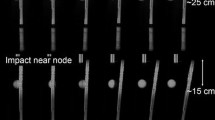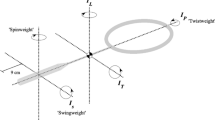Abstract
Topspin has become a vital component of modern day tennis. Ball-to-string bed and inter-string friction coefficients can affect topspin generation from a racket. The aim of this research was to determine the effect of string bed pattern on topspin generation. Tennis balls were projected onto nine head-clamped rackets with different string bed patterns. The balls were fired at 24 m/s, at an angle of 26° to the string bed normal with a backspin rate of 218 rad/s and outbound velocity, spin and angle were measured. Outbound velocity was shown to be independent of string bed pattern. Outbound angle increased with the number of cross strings, while outbound topspin decreased. In the most extreme case, decreasing the number of cross strings from 19 to 13 increased rebound topspin from 117 to 170 rad/s.









Similar content being viewed by others
References
Choppin SB, Goodwill SR, Haake SJ (2011) Impact characteristics of the ball and racket during play at the Wimbledon qualifying tournament. Sports Eng 13:163–170
Goodwill S, Capel-Davies J, Haake S, Miller S (2007) Ball spin generation of elite players during match play. Tennis Sci Technol 3(1):349–356 International Tennis Federation, London
Kelley J, Goodwill S, Capel-Davies J, Haake S (2008) Ball spin generation at the 2007 Wimbledon qualifying tournament. Eng Sport 7(1):571–578 Springer, France
Goodwill SR, Chin SB, Haake SJ (2004) Wind tunnel testing of spinning and non-spinning tennis balls. J Wind Eng Ind Aerodyn 92:935–958
Mehta R, Pallis J (2001) The aerodynamics of a tennis ball. Sports Eng 4:1–13
Allen T, Haake SJ, Goodwill SR (2011) Effect of tennis racket parameters on a simulated groundstroke. J Sports Sci 29:311–325
Goodwill SR, Haake SJ (2002) Why were ‘spaghetti string’ rackets banned in the game of tennis? In: Ujihashi S, Haake S (eds) 4th International conference on sports engineering. Blackwell Science, Kyoto, pp 231–237
Goodwill SR, Haake SJ (2004) Ball spin generation for oblique impacts with a tennis racket. Soc Exp Mech 44:195–206
Cross R (2000) Effects of friction between the ball and strings in tennis. Sports Eng 3:85–97
Allen TB, Haake SJ, Goodwill SR (2010) Effect of friction on tennis ball impacts. Proc Inst Mech Eng P J Sports Eng Technol 224:229–236
Haake SJ, Allen TB, Jones A, Spurr J, Goodwill S (2012) Effect of inter-string friction on tennis ball rebound. Proc Inst Mech Eng J J Eng Tribol 226:626–635
Kawazoe Y, Okimoto K (2008) Tennis top spin comparison between new, used and lubricated used strings by high speed video analysis with impact simulation. Theor Appl Mech Jpn 57:511–522
Lindsey C (2011) Spin and string pattern. The tennis warehouse. http://twu.tennis-warehouse.com/learning_center/stringpattern.php. Accessed 18 Jan 2013
Cross R, Lindsey C (2013) Spin and string patterns old, new, and illegal. The tennis warehouse. http://twu.tennis-warehouse.com/learning_center/spinpatterns.php. Accessed 18 Jan 2013
Fischer W (1977) Tennis racket. US Pat 4(273):331
ITF Technical Department. International Tennis Federation. www.itftennis.com/technical. Accessed 02 Oct 2012
Groppel JL, Shin IS, Spotts J, Hill B (1987) Effects of different string tension patterns and racket motion on tennis racket-ball impact. Int J Sport Biomech 3:142–158
Brody H (1987) Models of tennis racket impacts (Modeles d’impacts sur raquette de tennis). Int J Sport Biomech 3:293–296
Cross R (1998) The sweet spots of a tennis racket. Sports Eng 1:63–78
Kawazoe Y (1997) Experimental identification of a hand-held tennis racket and prediction of rebound ball velocity in an impact. Theoret Appl Mech 46:177–188
Allen T, Goodwill SR, Haake SJ (2009) Comparison of a finite element model of a tennis racket to experimental data. Sports Eng 12:87–98
Cross R, Lindsey C (2005) Racquets, strings, balls, courts, spin and bounce. Technical tennis. Racquet Tech Publishing, California
Acknowledgments
The authors would like to thank Mr Terry Senior for designing and developing the test rig and Prince Sports for providing equipment for testing. The authors also like to thank Dr Simon Choppin and Dr Heather Driscoll for proof reading the manuscript.
Author information
Authors and Affiliations
Corresponding author
Rights and permissions
About this article
Cite this article
Nicolaides, A., Elliott, N., Kelley, J. et al. Effect of string bed pattern on ball spin generation from a tennis racket. Sports Eng 16, 181–188 (2013). https://doi.org/10.1007/s12283-013-0118-y
Published:
Issue Date:
DOI: https://doi.org/10.1007/s12283-013-0118-y




